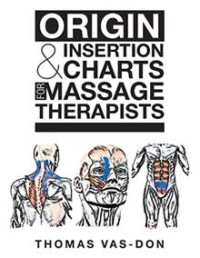Title: Origin & Insertion Charts for Massage Therapists
Author: Thomas Vas-Don
Publisher: XlibrisAU
ISBN: 978-1-5245-2156-1
Genre: Medical Textbook/Education/ Reference
Pages: 96
Reviewed by: Barbara Miller
Pacific Book Review
For those of us that cannot memorize the names of muscles, like Trapezius (rear shoulder – a hint would be the word ‘trapeze’) or where exactly is your Flexor Digitorum Brevis (in your foot), author Thomas Vas-Don’s book is perfect to keep handy. In the Origin & Insertion Charts for Massage Therapists, Vas-Don creates an easy to follow, step-by-step guide as reference for CMTs to use for the alleviation of pain and allowing for deep relaxation of their clients.
Vas-Don certainly knows about pain – at the age of 21 he was injured and faced the possibility of being in a wheelchair for the rest of his life. With determination and willpower, he is now a black-belt martial artist. Now that’s a “Wow” story in and of itself! Reducing the understanding of muscle groups to an ordinary explanation, Vas-Don created an ingenious methodology of referencing the sections of the body, then taking each area and revealing how best to massage and insert pressure to relieve stress and discomfort. He then correlates each of the sections with drawings of the body, and coloring in the muscles in red or blue. For a professional masseuse, following the guidelines of Vas-Don’s book, the results would rival any chiropractic or doctor’s remedy.
It is very easy to follow. Let’s say you have pain in the heel of your foot. Turning to the ankle and foot section, you would look at the various muscle groups and determine which one is where your pain is located. Then, the pattern of massage along with the number of degrees of rotation, if appropriate, are explained, while a diagram showing the outline of the subdermal muscle is revealed allowing the masseuse to have x-ray vision, so to speak, in targeting the specific area.
Rarely is a textbook genre publication so interesting to read – page by page. However we each have something in common – our body – and knowing more about yourself is an ancillary benefit of reading this book. I wholeheartedly recommend this book to a wide variety of people from students of medicine, certified massage therapists, and everyone with the curiosity to know more about how us humans are put together.



Follow Us